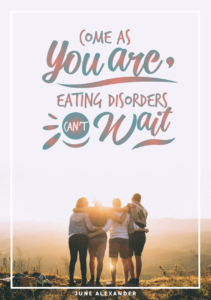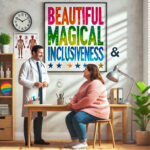Therapist in eating disorder recovery: Stop stereotypes, start healing

Therapist in eating disorder recovery: Stop stereotypes, start healing
Many people with an eating disorder suffer alone, sometimes until it’s too late to survive, let alone thrive. Therapist Jacki LaRusso explains why we can’t afford to wait in recognizing symptom diversity.
Young, thin, white, female, and afraid to gain weight. I fitted this image of eating disorders portrayed in the media. Luckily I was offered help that saved my life. The sad truth is that eating disorders are the highest cause of death from related mental illnesses (ANAD, 2019), and my suffering is only a tiny piece of a large puzzle that comprises people who suffer from an eating disorder worldwide, including those I now help treat.
My story
When I was 13 years old, I was going through a hard time. I had just moved in with my dad and step-mom, as my mother was in treatment for a serious mental illness and could no longer care for me. My step-mom didn’t love the idea of sharing my dad or her home with another female. I was in a new town, school and household, and had little space to feel accepted during a time when I really needed nurturing.
Simultaneously, I entered that awkward-teenage puberty stage of life, and naturally my body also began to change. It was one more way that made me I feel like my world was out of my control. Unable to fully understand how the current life circumstances had likely led me to feel insecure, I blindly blamed my unhappiness on being too fat to be loved and accepted by others and myself. Once this false notion sunk into my mind, I began to focus on losing weight.
Unaware of what was really happening, that an illness was taking hold, I believed that losing weight was the key to making me happy again. Within a year my mission for achieving for happiness had developed into severe anorexia.
The day came when parents of friends convinced my school teachers to sit me down with my dad and step-mom and arrange an intervention. I thought they were overreacting but I didn’t want to disappoint them so I agreed to go to the treatment they recommended. At my first treatment session, I consented to follow the plan to eat more and exercise less to start to heal my body. I didn’t think anything was wrong with me so I thought this would all be easy. The week following that initial treatment session was, for lack of better words, hell.
Trust led to breaking through denial
I tried hard to eat and reduce my movement but for some reason felt powerless to do so and was confused as to why. In my next treatment session, I explained this to my dietician, Donna, and she listened calmly until I finished. Donna was gentle and loving in explaining that I was struggling with a severe eating disorder. Her genuine care, education, and compassion helped me trust her and break through my denial. With years of therapy (and yes, I still go to therapy now as part of my wellness), a lot of tears, hard work, and support from my team and community I was able to enter into full recovery.
Because the eating disorder showed up in a societally recognizable way, my community intervened early, which research shows significantly increases likelihood of full recovery (Rowe, 2017). The power of healing services in my own recovery fueled my passion to become a therapist myself, and I have been treating eating disorders for almost a decade now.
Denial of diversity means some populations are overlooked
Learning is ongoing. My patients teach me that there is a dearth of understanding in the world on how to recognize and treat eating disorders.
- Males: A male client, by the time he met me, had been dealing with his undiagnosed anorexia for 10 years with all the classic signs that fit the disease. His doctor of many years admitted to me he had “no idea a man could have an eating disorder” and may have unintentionally contributed to my client’s anorexia by applauding him for dieting and excessive exercising—despite the fact that my client was underweight, eating one meal a day, anemic, thinking about his body/food/exercise all day and having severe joint pain.
- Everyone has their own “normal” healthy weight size: A teenager was at a weight that was healthy for her, but which society judged as “too fat.” When this teenager lost weight, everyone thought she “looked normal,” which led them to give her positive feedback. The family congratulated the 13-year-old on her weight loss, despite her being at an age of puberty during which there can be healthy weight gain, not loss. This girl was also struggling with her mental health. Privately, she was in cycles of restriction and binge eating and hating her curvy body when she fed it well. No one asked her about her relationship with herself when she had anxiety ordering a meal at restaurants, was isolated from her social circle, and spent hours getting dressed to leave the house for school each day. This girl struggled in silence for five years.
- Adults experience eating disorders too: Another client has had an extensive history of dental exams with tooth decay and root canals. Because she is an older adult, her dentist assumed she “had bulimia” when she was “younger” forcing my client to feel she needed to lie and say she just had a “sugar problem.” Her shame was such that she felt unable to tell the truth that she still struggled with her bulimia.
For recovery to occur, it is essential to replace those interactions that lead people with eating disorders to suffer in silence with interactions based on education and awareness so that these people can be guided in accessing the help they deserve.
Appearance is not an eating disorder indicator
Eating disorders impact all genders, ages, sexual orientations, cultures, races, body types and socioeconomic statuses. You cannot tell someone has an eating disorder simply by looking at their appearance. Some people eat too much, too little, get rid of their food in unhealthy ways, or have so much rigidity around how they eat and exercise they can barely function.
Unfortunately many people do not know this diverse picture of eating disorders. Masses of people who suffer go unnoticed, are plagued with their own denial, and sink deeper into their illness alone, sometimes until it’s too late to survive, let alone thrive.
The blindfold of denial is a dangerous phenomenon. So how do we help and accurately detect an eating disorder in those we care about? Check out the wonderful resources below. We can work together to get people the life-saving treatment they deserve. They can’t afford to wait.
Further information on true indicators
Link on signs and symptoms of eating disorders:
https://www.nationaleatingdisorders.org/information-eating-disorder
Link on research about importance of early detection (Rowe, 2017):
https://www.ncbi.nlm.nih.gov/m/pubmed/29101919/
Link on research about mortality rate (ANAD, 2019):
https://anad.org/education-and-awareness/about-eating-disorders/eating-disorders-statistics/
About World Eating Disorders Action Day 2019
This year grassroots activists, volunteers, and over 250 organizations in 40+ countries are calling for caregivers to receive support, health care workers to be properly trained, and access to immediate, evidence-based treatment.
Why We Can’t Afford to Wait
- Worldwide over 70 million people are estimated to be affected by an eating disorder,
- Eating disorders have the HIGHEST MORTALITY RATE of any psychiatric illness
- Eating disorders affect people of all genders, sexual orientations, ages, socioeconomic class, abilities, races, and ethnic backgrounds. It is time to take action.
- Good news! When treated EARLY and correctly, eating disorders have the highest and fastest recovery rate!
How to support World Eating Disorders Action Day, June 2, 2019
- Join the movement, show your purple on social media! Use hashtag #ShowUsYourPurple
- Follow conversation on social media. Use hashtags #ShowUsYourPurple #WeDoActNow
- Host or attend an event. See http://www.worldeatingdisordersday.org/2019-events-2/
- Donate. To support the work see http://www.worldeatingdisordersday.org/get-involved/participating-organisations/.
- Discuss eating disorders. Through open, supportive dialogue, we can create change.
E-book release: Come as you are, eating disorders can’t wait

As a Participating Organisation supporting 2019 World Eating Disorder Action Day, The Diary Healerhas released a new ebook, Come as you are, eating disorders can’t wait. Stories from around the world illustrate that recovery from an eating disorder IS possible, at every age. The first step, is to seek help. Click here to purchase a copy for $9.97 (AUD) – all profits support eating disorder services.





